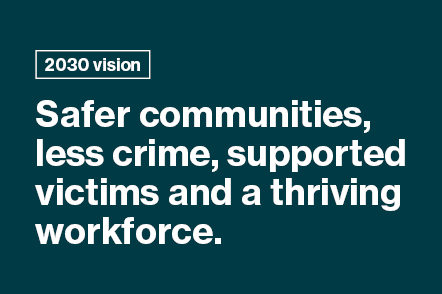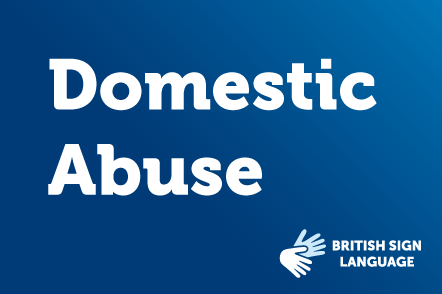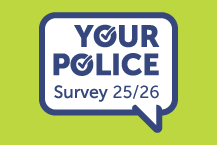Local policing, technology in policing and search guidance covered by Chief Constable
Chief Constable Jo Farrell shared progress on a new community policing model, emphasised her support for using technology to make Police Scotland more efficient and effective, and outlined new interim guidance on searching, during a public meeting in Edinburgh today, Thursday, 26 June.
Speaking at a meeting of the Scottish Police Authority Board, Chief Constable Farrell also updated that officers had this week made a further arrest as part of Operation Portaledge, taking the total to 49.
The Chief Constable’s report to the board can be read here, and her verbal input is below:
My Annual Assessment of Policing for 2024-25, published this month, underlines that Scotland remains a safe place to live and work and that our policing is of high quality.
To build and implement a sustainable Service able to effectively meet emerging challenges and deliver safer communities, less crime, supported victims, and a thriving workforce, we’re progressing the next phase of police reform.
A key element of that vision is a strengthened approach to local policing which prioritises frontline services, better connects with communities, and improves problem solving, proactivity and prevention to get on top of demand and deliver better outcomes for communities.
In my report, I give an update on the development of our enhanced model of community policing, as we move toward a proof of concept in the Forth Valley area. The approach follows a detailed review of existing arrangements, including listening to officers, staff and partners, and members of the public.
We want our new approach to more clearly define what our response teams do and give them better support for less urgent demand. We think this can improve our victim centred approach, for example having fewer cancelled appointments because of competing demand.
Successful implementation relies on reform work which creates efficiencies, for example the introduction of technology, and which reduces the time officers spend at court when they don’t give evidence or responding to mental health incidents, when other agencies are better able to help people.
At the same time, maximising the frontline by modernising the workforce and deploying experienced officers to roles which require warranted powers, while also increasing the pool of officers available for operational or high demand deployments is essential to support officers, staff and volunteers to deliver for communities.
My Annual Assessment provides an overview of the strong progress on this necessary change and the impact it has had.
We’ve changed policy and we’re consulting on shift changes to make more officers available for frontline deployments, including at weekends and on high demand days.
We’re taking a proportionate response to crime and an appropriate approach to direct measures, including recorded police warnings, so officers can focus on addressing threat, harm, risk and vulnerability.
We’re collaborating with partners to provide better services in the criminal justice system and in response to mental health incidents, while reducing demand on police officers.
I want to thank colleagues across the criminal justice system for playing their part in this change and we are beginning to see returns on this focus, with a reduction in officer citations for court. To provide a sense of the scale of this, in 2022-23, we had on average 575 officers cited for court each day. 575 officers each day.
In 2024-25, that’s reduced to 418 on average, which is still far too many, but the number is going in the right direction. These are officer days which are available for other duties, and rest days which are not disrupted.
In the mental health space, we’re working with NHS24 and staff at Contact, Command and Control (C3) to refer more calls to health colleagues, to help people get help from those best able to give it to them, while reducing officer hours spent responding to incidents.
In the last quarter of 2024-25, over 1300 referrals were made by Police Scotland to the Mental Health Pathway, an important release of demand on officers.
We introduced body worn video in the Tayside area and, earlier this month, we expanded the national roll-out for over 10,000 officers and staff into Highland and Islands Division and into North East Division in August, a game changer for policing.
The Digital Evidence Sharing Capability is cutting down on thousands of hours spent physically collecting evidence like CCTV on discs and pen drives by allowing files to be uploaded.
We must continue to drive efficiencies and improve ways of working and make conscious and deliberate decisions on reinvesting to prioritise the frontline to deliver for communities.
I’ve been clear about the role technology must play in delivering more efficient and more effective policing in Scotland.
Just this week, I spoke about this in Edinburgh at an event hosted by Holyrood Events for academics, international law enforcement colleagues and others interested in technology, policing and public trust.
During the day we heard powerful lived experience from a victim of online fraud and underlined how widespread use of technology is, including by criminals.
I’m passionate about meeting our positive duty to use new technology for law enforcement. Passionate about keeping people safe from harm, protecting the vulnerable and bringing criminals to justice. Using new technology can assist in that mission and we will not step back from our positive duty.
I was also clear that our approach, supported by the Authority, the Biometrics Commissioner, and others is legal, ethical and underpinned by our values and human rights.
That’s why we’ve worked with the Authority to develop and use a rights-based pathway and an approach to data ethics that can give confidence and necessary scrutiny to new technology being used by policing.
As you know, that approach has informed progress on the national conversation on live facial recognition. This technology can enhance our capability to keep people safe, prevent and detect crime. It is already well established in our daily lives, in shops, supermarkets and at airports and by other police Services south of the border.
Along with the Biometrics Commissioner and the Scottish Police Authority, we co-hosted the Scottish Biometrics conference last June and a live facial recognition event in May this year.
In April, we held five focus groups with organisations from criminal justice, equalities, victims support services, academia, and government bodies.
With the Scottish Police Authority, we’ve also conducted some surveying which has had mixed responses.
We understand that people need assurance about how Police Scotland would use live facial recognition, in what circumstances, and with what checks and balances.
So, although we have taken a big step forward with the conversation about live facial recognition being deployed by Police Scotland, there are many more steps to take, including further engagement with stakeholders and the public, including developing a business case and necessary financial support and policy and operating procedures.
I want to be clear that we will move ahead with that more detailed work to develop a live facial recognition capability. It will take some time, and it will ensure our use of this technology, as with other technologies, is governed by whether it is appropriate, proportionate and necessary, and by high levels of governance and scrutiny.
Returning to my report, I describe enforcement, investigation and criminal justice outcomes including in relation to murder, missing persons, serious sexual offences, and the dangerous use of offroad motorcycles and electric scooters, providing insight into the broad policing our officers, staff and volunteers deliver for communities day in, day out.
Just this week, we made a further arrest in relation to Operation Portaledge, taking the total number of arrests to 49 in relation to targeted attacks in the East and West of the country.
The support of our communities is essential when it comes to tackling serious organised crime, preventing violence and getting justice for victims. I want to thank the public for their assistance so far and encourage anyone else with information to come forward.
I also highlight planning for the policing of events including the Tall Ships this summer and next year’s Commonwealth Games.
Earlier this month I authorised the deployment of a number of Police Scotland officers to support colleagues in the Police Service of Northern Ireland.
Close co-operation between UK police services is essential and all services benefit from receiving and providing mutual aid when it's required.
As the UK's second largest police service, it's important we continue to demonstrate our support and the desire for our officers highlights the professionalism, human rights based approach and standard of policing here in Scotland.
As always, I approved the deployment following careful consideration and it in no way affects Police Scotland's ability to meet the policing requirements of our communities and those deployed have now all returned to Scotland.
Earlier this month, Baroness Louise Casey’s national audit on group-based child sexual exploitation and abuse was an important report on a complex issue, and we are carefully considering the content and recommendations.
Additionally, I outline that Police Scotland is undertaking a review of previous cases and on-going investigations across Scotland. At the heart of our mission is protecting vulnerable people and the needs of survivors are always at the heart of our victim centred approach.
I outline our ongoing engagement with the Scottish Government and across political parties, the Scottish Violence Reduction Unit, other key partners and the third sector with a shared commitment to reduce the profound harm that violence can have on individuals, families, and broader communities.
In my report, I illustrate examples of how we are supporting great work with, and for, young people across Scotland. The shared challenge for policing and right across society is how we give young people more safe spaces and create further opportunities for prevention.
We know our officers, staff and volunteers can only deliver for our communities if they are supported to thrive and my report describes important investment in our frontline at Contact, Command and Control (C3) Division where around 500 service advisers have had their pay grade upgraded.
Before I conclude I will provide an update on searching as it relates to sex and gender.
I want to repeat some of the principles I covered in May. The issue of sex and gender is complex, we do not wish to misstep in this space and our broader review of sex and gender continues to take into account all the views, the legislation, the guidance and the legal advice.
Following the UK Supreme Court judgment in April, we continue to take specialist human rights legal advice and, based on that advice and engagement with staff associations and trade unions, we have developed and issued interim guidance on searching in custody or as part of a stop and search which involves the removal of more than an outer jacket, gloves, headgear or footwear.
This is a complex area and the guidance is not without potential unintended consequences, however we must ensure Police Scotland acts lawfully in meeting its duty under both the Equality Act and the Human Rights Act. We must give officers and staff confidence that they are conducting searches lawfully, and we must protect officers and staff from potential challenges, which could include criminal allegations.
We are sharing this interim guidance with officers and staff, including with our non-statutory staff associations, to ensure everyone who might find themselves involved in a search has received and understands this information.
We’ve published the interim guidance on our website and I will outline some of the broad headlines.
We will conduct searches in custody or as part of a stop and search interaction which involve the removal of more than an outer jacket, gloves, headgear or footwear, on the basis of biological sex. This means in practical terms that these searches will only be carried out by officers or staff of the same biological sex.
There is one important exception. When an individual whose lived gender differs from their biological sex requests to be searched by an officer of their lived gender, efforts will be made to ensure an appropriate officer conducts the search, if operationally viable to do so.
In these circumstances, written consent will now be required from the authorising officer, the transgender person to be searched and the officer or officers conducting the search.
The interim guidance requires our transgender officers and staff to search in line with their biological sex. We recognise that transgender colleagues may wish to exempt themselves from these types of search on this basis to avoid having to disclose their gender identity. Our operational practice permits officers to be excused from searches for a variety of reasons. The officer will state that they wish to be excused from searching, with no further justification required. There will be no career detriment to them for so doing.
I want to recognise that this interim guidance will have an impact on people and underline that our objectives here are to preserve people’s dignity, ensure Police Scotland and our officers and staff are acting lawfully and in line with the Equality Act and the Human Rights Act and to protect our officers and staff from potential challenge.
As part of our communication and engagement programme, we’re ensuring police officers, custody staff and others fully understand the interim guidance, while also making clear the wellbeing support that is available for those who are affected.
We’ll continue to progress our broader sex and gender review and we’ll make further, relevant updates as required. I’ll pause there.






